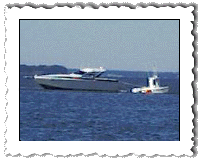

 |
|
A hint of tropics in the waterLindsay McRory
November
17, 1995
 We left Belhaven at 7 a.m. sharp under clear skies and 25 mph
winds. The weather forecast predicted that winds would drop off in the
afternoon, so we were not concerned about a repeat of bad weather. We left Belhaven at 7 a.m. sharp under clear skies and 25 mph
winds. The weather forecast predicted that winds would drop off in the
afternoon, so we were not concerned about a repeat of bad weather.
Our next stop was Oriental, North Carolina. It was a bumpy ride. In
typical northern intercoastal tradition, larger bodies of water are joined
by canals, otherwise known as land cuts. The largest landcut in the region
is the Pungo River canal, which brought us into Belhaven.
We arrived in Oriental without much excitement, and decided to spend a
couple days here waiting on a mail drop. No, there isn't a Chinese
restaurant in Oriental. But the area did provide an excellent opportunity
to stock up on gear and supplies. Whittaker Creek marina had the best
selection I've seen to date of gear, charts, and just about anything else
you might want. But everyone seemed to be itching to move south with the
good weather. Nights in the low thirties are just too darn cold. So, as
soon as the mail was picked up, we cast off and left this nice spot
behind.
The Adam's Creek canal led us from Oriental to the Beaufort area of
North Carolina. Unlike the last two canals, the Adam's Creek canal leads
to something new, like opening a curtain to a new room. Gone is the
root-beer-colored water, straw brown banks, and the swamp look. The water
is clear and things start taking on a more tropical look. Walter Cronkite
wrote an article about the Intercoastal for one of the waterway guides and
titled it "Navigating the Ribbon of Sunshine." Of all the things we could
think of to call the Intercoastal Waterway, "ribbon of sunshine" was not
one of them. But once we moved through the Adam's Creek canal into these
new waters, we started to change our minds.
In most places, the actual channel within the Intercoastal is narrow,
even when the waterway spreads wide in the larger, shallow bodies of
water. For most sailboats, this restriction on course is not a problem.
Most sailboats travel at 5 to 10 mph and have lots of time to verify and
reverify their position in the channel. For powerboats, it can be a
problem. A fast powerboat traveling at 30 mph or more has less time to
verify and react. Most places on the Intercoastal offer no mercy. At
times, an error of 30 feet or less will slide a boat into 6 inches of
water. While coming out of Adam's Creek we were passed by a 35-foot
powerboat planing along at 35 mph. Denise and I noticed that he was taking
the markers a little on the wide side. An hour later, we passed him as he
was being towed off a mud bank. He passed us again two hours later. Well
he didn't really pass us, he buzzed by us within 10 feet at full throttle.
He must have been a little embarrassed (or mad) because I took a few
photographs of him getting towed off. Two minutes after passing us for the
second time he flew right up another shoal. It was a tough one to figure
because the 40-foot-wide channel was perfectly straight for miles, and
well-marked. But if you figure it out, 35 mph is 51 feet per second, so it
would only take a couple of seconds to venture far enough off course to
ground. He was having a real bad day. On the other side, the Beaufort boat
towing company was thriving.
  After a long day, we docked up at Dudley's
Marina in Swansboro. Kita and Wesley ran off some pent-up energy and then
it was off to bed. After a long day, we docked up at Dudley's
Marina in Swansboro. Kita and Wesley ran off some pent-up energy and then
it was off to bed.
|




